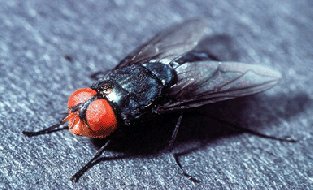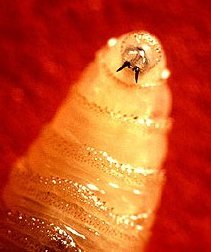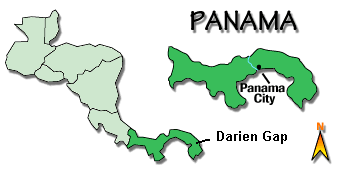Nailing the Screwworm
 The screwworm, Cochliomyia hominovorax, is an aggressive bot fly (family Calliphoridae) that lays its eggs around the edge of any skin cut or abrasion in most wild or domestic animals. Fly larvae infest the wound, feed on surrounding healthy tissue, and prevent the injury from healing. Infested animals eventually stop eating and usually die if not treated. During the first half of the 1900’s, screwworms caused more than $100 million per year in economic losses to farmers and ranchers in states bordering the Gulf of Mexico.
The screwworm, Cochliomyia hominovorax, is an aggressive bot fly (family Calliphoridae) that lays its eggs around the edge of any skin cut or abrasion in most wild or domestic animals. Fly larvae infest the wound, feed on surrounding healthy tissue, and prevent the injury from healing. Infested animals eventually stop eating and usually die if not treated. During the first half of the 1900’s, screwworms caused more than $100 million per year in economic losses to farmers and ranchers in states bordering the Gulf of Mexico.
 The use of sterile males to eradicate screwworm populations was first suggested in 1937 by E. F. Knipling, an entomologist with the United States Department of Agriculture (USDA). Over the next few years, Knipling and his associates developed methods for mass-rearing screwworms on a diet of raw meat, separating them by sex in the pupal stage, and treating the males with radiation to induce sterility.
The use of sterile males to eradicate screwworm populations was first suggested in 1937 by E. F. Knipling, an entomologist with the United States Department of Agriculture (USDA). Over the next few years, Knipling and his associates developed methods for mass-rearing screwworms on a diet of raw meat, separating them by sex in the pupal stage, and treating the males with radiation to induce sterility.
 Field trials were conducted in 1952 on Sanibel Island, off the western coast of Florida. These experiments were designed to test the feasibility of mass releases and to evaluate how well sterile males competed with wild-type males in attracting and mating with virgin females. Preliminary results were promising enough to warrant a full-scale eradication project two years later on Curaçao, a small island in the Caribbean Sea. Knipling and his associates reared and released nearly 70,000 sterile males per week and achieved complete eradication of the fly population within four or five generations (13 weeks).
Field trials were conducted in 1952 on Sanibel Island, off the western coast of Florida. These experiments were designed to test the feasibility of mass releases and to evaluate how well sterile males competed with wild-type males in attracting and mating with virgin females. Preliminary results were promising enough to warrant a full-scale eradication project two years later on Curaçao, a small island in the Caribbean Sea. Knipling and his associates reared and released nearly 70,000 sterile males per week and achieved complete eradication of the fly population within four or five generations (13 weeks).
The dramatic success on Curaçao prompted the USDA to sponsor a much larger eradication project in the southern United States during 1958-59. As many as 25 million sterile males were reared and released each week for an eradication effort that encompassed 85,000 square miles in parts of Florida, Georgia, and Alabama. The project employed nearly 500 people, required 20 aircraft to deploy the sterile flies, and cost over $10 million. But after 18 months of intensive effort, the screwworm was successfully eradicated from the southeastern United States saving ranchers an estimated $20 million annually in losses.
After eliminating screwworms from the southeastern United States, the eradication program moved into the Southwest where it tackled infestations along a 1500-mile border between the United States and Mexico. In 1962, a rearing facility opened in Mission, Texas that could produce more than 150 million sterile flies per week. By 1966, releases of up to two billion flies per year had driven screwworms to extinction north of the Mexican border.
 The eradication effort continued southward through Mexico during the 1970’s and 1980’s. A new rearing facility, capable of producing 500 million sterile males per week, opened near Tuxtla Gutierrez, Chiapas, Mexico in 1976. By 1987, Mexico was largely “fly free” so the eradication effort moved southward into the countries of Central America during the 1990’s. Continued success resulted in the elimination of screwworms from Belize and Guatemala (1994), El Salvador (1995), Honduras (1996), Nicaragua (1999), and Costa Rica (2000). A new rearing facility is currently being built near Pacora, Panama. When it opens in 2003 it will produce 200 million flies per week for distribution in Panama and the Caribbean islands. Scientists hope to create and maintain a barrier zone of sterile flies at the Darien Gap in southern Panama to prevent any northward migration of flies out of South America.
The eradication effort continued southward through Mexico during the 1970’s and 1980’s. A new rearing facility, capable of producing 500 million sterile males per week, opened near Tuxtla Gutierrez, Chiapas, Mexico in 1976. By 1987, Mexico was largely “fly free” so the eradication effort moved southward into the countries of Central America during the 1990’s. Continued success resulted in the elimination of screwworms from Belize and Guatemala (1994), El Salvador (1995), Honduras (1996), Nicaragua (1999), and Costa Rica (2000). A new rearing facility is currently being built near Pacora, Panama. When it opens in 2003 it will produce 200 million flies per week for distribution in Panama and the Caribbean islands. Scientists hope to create and maintain a barrier zone of sterile flies at the Darien Gap in southern Panama to prevent any northward migration of flies out of South America.
Link to more information about the screwworm eradication program:

